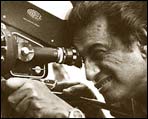
![]() Festivals
Festivals
![]() Durga Puja
Durga Puja
![]() Associations
Associations
![]() Learn
Bangla
Learn
Bangla
![]() Beng.
Marriage
Beng.
Marriage
![]() Art &
Craft
Art &
Craft
![]() Great Indians
Great Indians
![]() Beauty
Care
Beauty
Care
![]() Recipe
Recipe
![]() Astrology
Astrology
![]() Beng.
Section
Beng.
Section
![]() Bengal
Bengal
![]() Calcutta
Calcutta
![]() Beng.
Calendar
Beng.
Calendar
![]() Wallpapers
Wallpapers
![]() Movie
Movie
![]() Music
Music
![]() E-Card
E-Card
![]() Shopping
Shopping
![]() E-Puja Room
E-Puja Room
![]() News
News
![]() E-mail
E-mail
![]() Month's Events
Month's Events
![]() Weather
Weather
![]() Chat
Chat
![]() Education
Education
![]() Join Us
Join Us
![]() Advertise
Advertise
![]() Website links
Website links
![]() Link to us
Link to us
![]() Guest Corner
Guest Corner
![]() Services
Services
![]() WebSite
Design
WebSite
Design

Satyajit Ray’s films come as close to complete personal expression as may be possible in cinema. There is perhaps no filmmaker who exercised such total control over his work as him. He was responsible for scripting, casting, directing, scoring, operating the camera, working closely on art direction and editing, even designing his own credit titles and publicity material.
Satyajit Ray was born in May 2, 1921, Kolkata, into an exceptionally talented
family who were prominent in Bengali arts and letters. His father died
when he was an infant and his mother and her younger brother's family
brought him up. After graduating from Presidency College, Calcutta, in
1940, he studied art at Rabindranath Tagore's University in Shantiniketan,
West Bengal. He took up commercial advertising and he also designed covers
and illustrated books brought out by Signet Press- including an edition
of Bibhutibhushan Bandyopadhya's novel, 'Pather Panchali', which later
became his first film.
In 1947 Ray established the Calcutta Film Society. During a six month trip to Europe in 1950, he managed to see 100 films, including Vittorio De Sica's Ladri di Biciclette (1948), which greatly inspired him. He returned convinced that it was possible to make realist cinema.
In 1955,
after incredible financial hardship (shooting on the film stopped for
over a year) his adaptation of Pather Panchali (Song of the Little Road)
was completed. In 1956 Cannes Festival, Indian cinema not known before,
assumed great importance with Pather Panchali. The film went on to win
numerous awards abroad including Best Human Document at Cannes. This success
launched an extraordinary international film career for Ray.
A prolific filmmaker, during his lifetime Ray directed 36 films, comprising
of features, documentaries and short stories. These include the renowned
Apu trilogy (Pather Panchali, Aparajito [1956] and Apur Sansar [1959]),
Jalsaghar (1958), Postmaster (1961), Charulata (1964), Days and Nights
in the Forest (1969) and Pikoo (1980) along with a host of his lesser
known works which themselves stand up as fine examples of story telling.
His films encompass a diversity of moods, techniques, and genres: comedy,
satire, fantasy and tragedy.
Usually
he made films in a realist mode, but he also experimented with surrealism
and fantasy like his Paras Pather (The Philosopher's Stone, 1958), a satirical
comedy about a poor clerk who chances on a magic stone that turns all
metal to gold. Jalsaghar is the story of Biswambhar, a feudal lord whose
act of refusal to change with time ruined him.
The inner struggle between traditional and modern values in Indian life
has coloured several other Ray films. Devi (The Goddess, 1960) is essentially
a story exploring the dangers of religious fanaticism and superstition.
To mark the centenary of the birth of Rabindranath Tagore, Ray made Teen
Kanya (Three Daughters) in 1961. The Postmaster is the first of the three-part
series making up Teen Kanya. The second episode, Samapti, is a comedy,
the third episode is Monihara, a ghost story. Ray's Kanchanjungha (1962)
marks the beginning of many things as it was his first original script,
his first picture in colour and the first film for which Ray composed
the score.
A disillusioned character of Ray's films is the taxi-driver protagonist of Abhijan (The Expedition, 1962). In Mahanagar (The Big City, 1963), Ray tackles the problem of whether or not both a husband and wife should take up jobs to maintain the family. Charulata (1964), which takes place in 1879 and is based on another story by Tagore searching a woman’s place in society. Most have agreed however that Charulata is among the very finest. Ray himself rates it as his favourite.
Films such as Kapurush-o-Mahapurush (The Crowd and the Holy Man, 1965), Nayak (The Hero, 1966) and Chiriakhana (The Zoo, 1967) contain little of Ray's personal touch. In Aranyer Din Ratri (Days and Nights in the Forest, 1969) that Ray isolates and removes a group of modern young Calcuttans from their natural habitat in order to study their attitudes and reactions and to reveal aspects of their respective characters. During the late-'60s, Ray made a fairytale for adults in Goopy Gyn Bagha Byne (The Adventures of Goopy and Bagha, 1968), written by his grandfather, Upendra Kishore Roy Choudhury and then went on to make The City Trilogy (comprising of Pratidwandi [The Adversary, 1970], Seemabaddha [Company Limited, 1971] and Jana Aranya [The Middleman, 1975]).
GREAT INDIANS || BENGALI SECTION || BENGALI MARRIAGE || WALLPAPER || BENGAL || WEATHER || E-CARD
MOVIE || WEBSITE LINKS || ASSOCIATIONS || SHOPPING || ASTROLOGY || MUSIC || BEAUTY CARE || NEWS
GUEST CORNER || FEEDBACK ||LINK TO US || FOR ADVERTISING || SERVICES || CONTACT || EDUCATION || JOIN US
Graphics, Sound or content copied or produced in part or whole in any media will be illegal.
Persons or websites caught using our material will be penalized.
Privacy Statement || Copyright
Copyright ©1999-2014 BANGALINET.COM